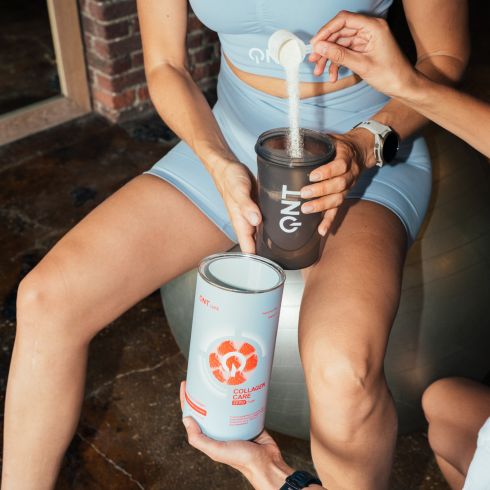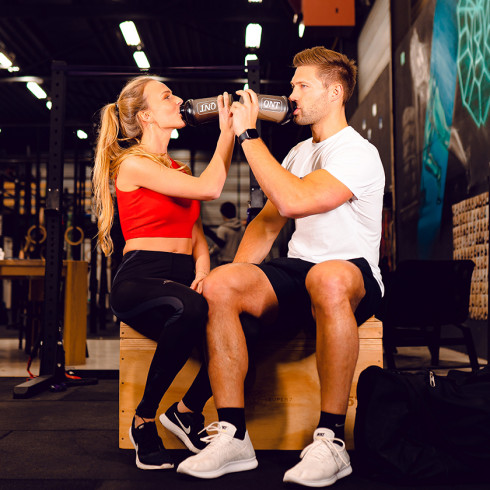Nutritional Timing and Recovery
TABLE OF CONTENTS
NUTRITION AND MUSCLE RECOVERY
Effective muscle recovery is essential to progress in sports and maintain a high level of performance. Whether the goal is to build muscle, improve endurance, or simply optimize training sessions, nutrition plays a key role in the regeneration process. In this article, we will explore three essential pillars to maximize recovery after exercise: nutrient timing, advanced supplementation, and optimal recovery strategies.
THE TIMING OF NUTRIENTS.
WHY IS TIMING IMPORTANT?
The timing of nutrient intake after training directly influences the body’s ability to recover. This critical period, often called the "metabolic window," occurs within 30 to 60 minutes after exercise. During this phase, muscles are especially receptive to nutrients, which promotes the repair of muscle fibers and the replenishment of glycogen stores.
THE METABOLIC WINDOW: A KEY MOMENT
This metabolic window represents a timeframe during which the body can absorb nutrients more efficiently. After intense effort, muscles are weakened by small lesions, and their glycogen stores (the storage form of glucose in muscles) are heavily depleted. To optimize recovery, it is essential to supply the body with the necessary nutrients within this limited period.
According to studies, the absorption capacity of carbohydrates and proteins is up to 50% higher during this window. This means muscles recover faster, glycogen is replenished more quickly, and protein synthesis is maximized. Missing this window limits the benefits of training, as muscles are not optimally nourished.
WHICH NUTRIENTS TO CONSUME DURING THIS PERIOD?
- Proteins: Central to repairing muscle tissue. Consuming 20–30 g of fast-digesting protein (whey protein, chicken breast, eggs) is recommended.
- Carbohydrates: Key for replenishing glycogen stores in muscles. Choose fast carbs (bananas, honey, fruit juice) for rapid absorption.
- Amino acids: BCAAs (leucine, isoleucine, valine) help reduce catabolism and stimulate muscle protein synthesis.
MISTAKES TO AVOID
- Skipping the post-workout meal: slows recovery and compromises muscle growth.
- Waiting too long: after 60 minutes, nutrient absorption decreases.
- Neglecting hydration: reduces the effectiveness of nutrition by limiting nutrient delivery to muscle cells.
WHEN SHOULD YOU EAT BEFORE A WORKOUT?
The timing of the pre-workout meal directly influences workout quality and subsequent recovery. To optimize available energy and avoid digestive discomfort, it is recommended to consume a balanced meal 1 to 4 hours before exercise.
CHOOSING THE RIGHT TIMING DEPENDS ON WORKOUT INTENSITY
- 3 to 4 hours before: A complete meal with complex carbs (rice, sweet potatoes, oats), lean proteins (chicken, fish), and vegetables.
- 1 to 2 hours before: A light, easy-to-digest snack with fast carbs (banana, whole grain bread) and some protein (yogurt, almonds).
- Less than 1 hour before: A protein shake or fruit (banana, apple) for quick energy.
WHY IS THIS TIMING IMPORTANT?
The body needs time to digest nutrients and convert them into usable energy. Eating too close to a workout can cause bloating or cramps, while eating too early can lead to an energy dip during exercise.
EXAMPLES OF PRE-WORKOUT MEALS
- 3 hours before: Brown rice, chicken breast, steamed vegetables.
- 2 hours before: A bowl of oatmeal with berries.
- 1 hour before: Greek yogurt with a banana.
- 30 minutes before: A protein shake or a piece of fruit.
Tip: Hydration is also crucial before a workout. Drink about 500 ml of water 30 minutes before starting to prevent dehydration.
IS IT OKAY TO EAT LATE AT NIGHT?
The question of whether eating late at night is acceptable often sparks debate. Contrary to popular belief, eating in the evening is not inherently bad for health or weight management. What truly matters is the total daily calorie intake and the quality of the foods consumed.
THE IMPACT ON METABOLISM
Many studies show that the body does not store fat more easily at night. This myth comes from the idea that metabolism slows in the evening, but in reality, the body continues to burn calories—even during sleep. What matters is overall energy balance: if you consume more calories than you burn, you will gain weight, regardless of the time of consumption.
WHICH FOODS TO FAVOR AT NIGHT TO AVOID WEIGHT GAIN?
- Chicken, turkey, or fish: lean protein sources that promote satiety while being easy to digest.
- Green vegetables: low in calories but rich in fiber, making them filling allies for dinner.
- Complex carbs (quinoa, sweet potatoes): provide slow-release energy and prevent nighttime cravings.
- Light dairy (Greek yogurt, cottage cheese): rich in protein and easy to digest.
MISTAKES TO AVOID
- Heavy meals: fatty and fried foods make digestion harder and disturb sleep.
- Fast sugars: they cause a spike in blood sugar, followed by rapid fat storage.
- Sugary drinks: to be avoided at night, as they increase calorie intake without nutritional benefits.
Tip: A light meal, rich in protein and fiber, is ideal for a late dinner without compromising your fitness goals.
ADVANCED SUPPLEMENTATION
BCAAs: LIMITING CATABOLISM
Branched-chain amino acids, known as BCAAs, include three essential amino acids: leucine, isoleucine, and valine. Unlike other amino acids, BCAAs are metabolized directly in the muscle rather than in the liver, which allows them to be used quickly during physical effort.
Why are BCAAs important?
- Reduced muscle catabolism: During calorie deficit or intense training, BCAAs help limit muscle breakdown.
- Improved endurance: They delay fatigue by providing energy directly to the muscles.
- Activation of protein synthesis: Leucine is one of the most crucial amino acids involved in triggering muscle growth.
Tip: Take 5 to 10 g of BCAAs before and after training to maximize their effects.
CREATINE: BOOSTING STRENGTH AND RECOVERY
Creatine monohydrate is one of the most researched and effective supplements for enhancing strength and supporting recovery. It works by increasing phosphocreatine stores in the muscles, allowing greater ATP (adenosine triphosphate) production — the immediate energy used during muscle contractions.
The benefits of creatine:
- Strength gain: Helps lift heavier weights, efficiently stimulating muscle growth.
- Improved muscular endurance: Intense efforts can be sustained for longer.
- Faster recovery: Reduces muscle damage and inflammation after exercise.
Tip: A daily intake of 3 to 5 g is enough to maintain optimal muscle levels.
BETA-ALANINE: DELAYING MUSCLE FATIGUE
Beta-alanine, a non-essential amino acid, promotes the production of carnosine, a compound that buffers acidity in the muscles. By increasing carnosine, it helps delay fatigue during intense and prolonged exercise.
The benefits of beta-alanine:
- Reduced lactic acid build-up: Allows you to push through more high-intensity reps.
- Improved explosiveness: Perfect for power-based exercises (sprints, weightlifting).
- Increased muscular endurance: Long sets become more manageable.
Tip: Take 3 to 4 g of beta-alanine per day, split into several doses to reduce tingling sensations (paresthesia).
You can find a solid dose in Pre-workout Overdrive.
STRATEGIES DE RECUPERATION.
SLEEP: AN ESSENTIAL ALLY
Sleep plays a crucial role in muscle regeneration, especially during deep sleep when hormones such as testosterone and growth hormone are secreted—both essential for muscle repair.
The different stages of sleep
- Light sleep (stages 1 and 2): Falling asleep and stabilization phase. The body relaxes and muscles begin to loosen.
- Deep sleep (stage 3): The body regenerates muscle tissue, strengthens the immune system, and produces growth hormone.
- REM sleep: The stage of intense dreams, key for memory and motor learning.
The importance of deep sleep for recovery
Deep sleep allows better repair of muscle fibers damaged during training. The brain detoxifies, the nervous system regenerates, which optimizes coordination and athletic performance.
How to optimize sleep quality?
- Maintain a consistent routine with regular sleep and wake times.
- Limit screen use before bed: blue light blocks melatonin.
- Create a proper environment: darkness, quiet, temperature between 18–20°C.
- Avoid heavy meals: prefer a light dinner to promote falling asleep.
Tip: Meditation and breathing exercises before bed improve sleep quality.
STRETCHING: OPTIMIZE FLEXIBILITY AND REDUCE TENSION
Stretching promotes muscle recovery and improves flexibility. After intense effort, it helps relax muscles, prevent injuries, and increase range of motion.
The different types of stretching
- Static stretching: Holding a fixed position for 20–30 seconds. Promotes muscle elongation.
- Dynamic stretching: Controlled movements, prepare the body for effort and improve mobility.
- PNF stretching: Alternating contractions and releases for advanced flexibility.
The benefits of stretching
- Reduces muscle tension and relieves soreness.
- Improves blood circulation for better recovery.
- Prevents injuries (strains, tears).
- Optimizes posture thanks to proper muscle alignment.
Practical tip: Spend 10 minutes stretching after each workout to maximize recovery.
MASSAGE: SPEED UP RECOVERY
Massages help reduce tension, improve blood circulation, and eliminate toxins. This limits post-training soreness and optimizes upcoming performance.
The different massage techniques
- Sports massage: Before or after effort, to prepare or relax muscles and reduce injury risk.
- Deep tissue massage: Releases deep tensions. Perfect for intensive training.
- Foam rolling (self-massage): Foam rollers to improve circulation and release muscle adhesions.
- Myofascial massage: Targets fascia to release chronic tension and improve mobility.
Frequency and tips for optimal recovery
- Sports massage: 1–2 times/week after intense sessions.
- Deep tissue: Once a month for deep release.
- Foam rolling: After every workout.
- Myofascial massage: Every 2 weeks to improve mobility.
Tip: Integrating massage into your sports routine helps prevent injuries and improves your range of motion.
Optimizing recovery involves proper nutrition, precise nutrient timing, targeted supplementation, and effective recovery strategies. By integrating these practices into your routine, you will maximize not only muscle growth but also performance in every workout.
COACH'S TIPS

- Respecting your eating habits is a good way to make progress. Muscles need to be nourished at the right time to optimize recovery.
- Stretching is important and not only helps with recovery but also prevents injuries. The best time to stretch is often debated, but by observing disciplines where flexibility is at its peak, such as dance, we notice that athletes stretch before, during, and after training. Perhaps that is the real solution?
Related posts
-
 Summer holidays: How to limit the damage?
Posted in: Our tips24/06/2021On holiday, we often tend to let ourselves go. Unless you're a hardcore sportsman, you tend to abandon your trainers...Read more
Summer holidays: How to limit the damage?
Posted in: Our tips24/06/2021On holiday, we often tend to let ourselves go. Unless you're a hardcore sportsman, you tend to abandon your trainers...Read more -
 Which fat burner to choose?
Posted in: Our tips26/05/2021To lose weight and burn fat, there is no secret: you have to do sport and take care of your diet. However, it is...Read more
Which fat burner to choose?
Posted in: Our tips26/05/2021To lose weight and burn fat, there is no secret: you have to do sport and take care of your diet. However, it is...Read more -
 Summer body edition for men: How to prepare your body?
Posted in: Our tips11/05/2021Gentlemen ? The return of the sun and its warm rays are almost here! The degrees are slowly but surely rising, but...Read more
Summer body edition for men: How to prepare your body?
Posted in: Our tips11/05/2021Gentlemen ? The return of the sun and its warm rays are almost here! The degrees are slowly but surely rising, but...Read more -
 9 good reasons to do sport.
Posted in: Our tips22/04/2021Sometimes the urge to exercise is not always there. And although we always tell ourselves that this year will finally...Read more
9 good reasons to do sport.
Posted in: Our tips22/04/2021Sometimes the urge to exercise is not always there. And although we always tell ourselves that this year will finally...Read more -
 Discover how to take care of your faithful companion: your shaker!
Posted in: Our tips07/04/2021In your bag, in your hand, in your sink, it is everywhere! The shaker is an essential element of any good training....Read more
Discover how to take care of your faithful companion: your shaker!
Posted in: Our tips07/04/2021In your bag, in your hand, in your sink, it is everywhere! The shaker is an essential element of any good training....Read more
Blog categories
Popular posts
-
 10 Expert Tips to Maximize the Effectiveness of Creatine26/08/2024Posted in: Our tipsThis article presents ten tips to maximize the effectiveness of creatine. It emphasizes the importance of choosing...Read more
10 Expert Tips to Maximize the Effectiveness of Creatine26/08/2024Posted in: Our tipsThis article presents ten tips to maximize the effectiveness of creatine. It emphasizes the importance of choosing...Read more -
 Looking thinner but at a heavier weight? Is that possible?04/10/2021Posted in: Our tipsAdvertising has shaped our thinking! We have been forced for years to believe that losing weight is the key to having...Read more
Looking thinner but at a heavier weight? Is that possible?04/10/2021Posted in: Our tipsAdvertising has shaped our thinking! We have been forced for years to believe that losing weight is the key to having...Read more -
 10 BENEFITS OF GLUTAMINE.02/01/2024Posted in: Our tipsDiscover the power of L-glutamine, an underrated superhero in the world of amino acids! Essential for revitalizing...Read more
10 BENEFITS OF GLUTAMINE.02/01/2024Posted in: Our tipsDiscover the power of L-glutamine, an underrated superhero in the world of amino acids! Essential for revitalizing...Read more -
 Proteins for weight loss !29/12/2023Posted in: Our tipsDive into the fascinating world of proteins and their key role in weight loss. Discover how to choose the best...Read more
Proteins for weight loss !29/12/2023Posted in: Our tipsDive into the fascinating world of proteins and their key role in weight loss. Discover how to choose the best...Read more -
 L-carnitine and weight loss.15/10/2024Posted in: Our tipsDiscover how carnitine works on weight loss, even without exercise. This article reveals whether this supplement can...Read more
L-carnitine and weight loss.15/10/2024Posted in: Our tipsDiscover how carnitine works on weight loss, even without exercise. This article reveals whether this supplement can...Read more

.jpg)

